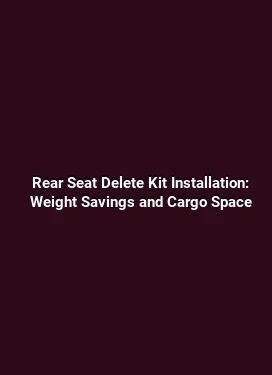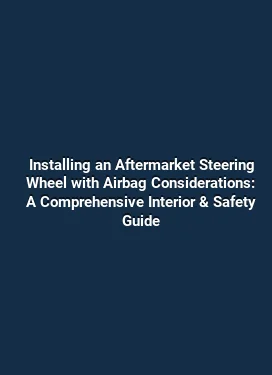How to Install Aftermarket Gauge Pod in A-Pillar Position
Adding an aftermarket gauge pod to the A-pillar can elevate both the functionality and the aesthetics of a vehicle’s cockpit. This guide delves into the practical steps, from selecting the right pod to securing it, routing wires, and ensuring that visibility and safety are preserved. Read on for a detailed, hands-on approach that emphasizes reliability, organization, and long-term durability.
A-Pillar Gauge Pod Overview

The A-pillar is the vertical frame that joins the windshield to the dashboard. Installing a gauge pod in this area provides quick visibility for critical engine and performance data while keeping the instrument panel uncluttered. The best pods are compact, designed to fit with minimal airbag interference, and made from materials that endure temperature fluctuations and sun exposure. When selecting a pod, consider the number of gauges, the orientation of the dials, and the mounting style (adhesive, screw-in, or bracket-based) to minimize vibration and maintain a clean appearance.
Key considerations include weight distribution, cable management, and the potential impact on airbags or sensor systems. While the A-pillar offers excellent line-of-sight, improper installation can create blind spots or snag hazards. The following sections break down the process into practical, repeatable steps that can be adapted to most vehicle types.
Choosing the Right Pod for Your Dashboard
Gauges come in a variety of forms, from traditional circular dials to compact digital displays. The right pod should complement the vehicle’s interior while providing accurate, readable data at a glance. When evaluating options, assess gauge compatibility (voltage, oil pressure, boost, RPM, temperature), pod depth, and mounting anchors. For vehicles with limited space, ultra-compact pods or modular pods that allow customization of gauge configuration can be an excellent choice.
Consider pod materials as well. ABS plastic offers a good balance of rigidity and cost, while aluminum or steel pods can provide superior durability in heat-prone environments. If the vehicle experiences high cabin temperatures, choose a heat-resistant finish and ensure that the pod’s surface does not reflect sunlight into the driver’s line of sight. A well-chosen pod reduces glare and maintains a clean, integrated look with the rest of the cockpit controls.
Choosing the right mounting method

Mounting options include adhesive-backed bases, screw-in brackets, and bracketless clamping solutions. Adhesive mounting is quick and non-invasive but may degrade with temperature changes or high humidity. Screw-in solutions offer greater security but require precise alignment and the potential for minor body work or trimming. Bracketless systems rely on the strength of the dashboard’s structure and the pod’s own mounting hardware. For most modern vehicles, a hybrid approach—adhesive backing supplemented by a securing strap or bracket—provides a balance of ease and reliability.
Gauge orientation and readability
Position the gauges so that the displays are within a comfortable arc of your natural line of sight. Face gauges outward or toward the driver depending on legibility and the gauge type. For digital readouts, angle the screen to minimize reflections from the windshield. If multiple gauges share a single pod, stagger the layout to keep each display legible without excessive head movement. A well-considered orientation reduces cognitive load during driving and supports safer monitoring of vehicle parameters.
Tools, Materials, and Prep
Gather a basic toolkit plus specialized items for automotive electrical work. This typically includes a trim removal tool set, a drill with appropriate bits, a torque wrench, a multimeter, wire-stripping pliers, heat shrink tubing, electrical tape, zip ties, and a panel adhesive or mounting adhesive compatible with automotive plastics. For wiring, you may need a fuse tap, 18-22 gauge wires for low-current signals, and weatherproof connectors if the installation exposes wires to cabin heat or moisture.
Before any modification, disconnect the vehicle’s battery to minimize the risk of short circuits or airbag deployment. Remove the necessary trim pieces around the A-pillar to access underlying panels. Work slowly to avoid cracking plastics and to preserve the interior’s finish. Document the wiring routes with photos as you go; this helps you reproduce the setup if you ever remove or relocate the pod.
Wiring and Electrical Integration
Wiring is the backbone of a safe, functional gauge pod installation. Plan the route from the pod to the instrument cluster or power source, keeping wires away from moving parts, hot surfaces, and any airbag modules. Use weatherproof connectors where exposure to humidity or rain is possible. If the gauges require power and a ground, choose a stable 12V source that remains active with the ignition off only if the gauges are designed to show status when the vehicle is off; otherwise, use a source that powers on with the ignition to avoid battery drain.
Neatly route wires along the A-pillar seam using clips or adhesive-backed channels. Avoid tight bends, which can fatigue wires over time. Secure all connections with heat shrink and electrical tape to insulate and protect from abrasion. When tapping into power, use a fuse-rated circuit and properly fuse the gauge pod’s circuit. A dedicated fuse keeps other circuits safe in the event of a short. Label wires to simplify future troubleshooting and for any potential upgrades.
Sensor compatibility and data accuracy
The accuracy of signals depends on clean wires and proper grounding. Ensure that sensor inputs do not share power wires with high-current devices, which can introduce noise. If a vehicle uses CAN-bus or other digital communication schemes, verify that the gauge pod is compatible with the vehicle’s data protocol or use a compatible signal adapter. Poor grounding can manifest as flickering gauges or erratic readings; secure a solid ground connection and verify continuity during testing.
Testing after installation
Once the pod is mounted and wired, reassemble trim pieces and reconnect the battery. Power up the vehicle and confirm that all gauges illuminate and register readings within expected ranges. Check for interference with the windshield wiper or A-pillar components. Lightly wiggle the pod to ensure there is no movement that could loosen fasteners. If there is any vibration, add supplemental mounting supports or adjust adhesive tension to dampen motion without stressing the dash plastics.
Placement, Visibility, and Safety Considerations
Safety is a primary concern with any aftermarket accessory. The A-pillar location should not obstruct airbag deployment paths or normal visibility during driving. Some late-model vehicles rely on the A-pillar for rollover protection; ensure the modification does not compromise the structural integrity or interfere with the trajectory of safety systems. When in doubt, consult the vehicle’s service manual or a qualified automotive technician before drilling or mounting.
To maintain a clean aesthetic and minimize glare, choose a pod color and finish that harmonizes with the interior trim. Use matte or satin finishes to reduce reflections that could impair vision in bright sunlight. Cable management is not only a matter of appearance—it prevents snag hazards and ensures the gauge pod remains stable during rough road conditions. Consider using split loom tubing or braided sleeving around wires for durability and a professional look.
Maintenance and Longevity
Regular inspection is essential for long-term reliability. Periodically inspect mounting points for looseness, especially after off-road use or frequent speed bumps. Check connector seals for signs of wear or moisture intrusion, and reseal as needed. Clean the gauge faces with a microfiber cloth and avoid harsh solvents that could degrade optics or seals. If the vehicle’s cabin experiences elevated temperatures, inspect heat-related wear such as fading adhesives or softened plastics, and replace components that show signs of deterioration.
Environmental exposure is a factor to consider. UV light can degrade plastics over time, so choosing UV-stable materials or finishing can prolong the pod’s life. For those who frequently adjust or upgrade gauges, use modular mounting solutions that allow quick swaps without new drilling. A modular approach reduces wear on the dashboard and keeps the interior consistent with evolving performance needs.
Advanced Tips for a Professional Finish
Professional-grade installations often incorporate tactile and visual cues that improve usability. For example, align gauge faces with a consistent baseline to create a cohesive instrument cluster impression. Use micro-texture finishes to reduce fingertip glare and enhance grip for any adjustment knobs. Consider subtle backlighting that complements the vehicle’s interior ambient lighting, ensuring readability at night without distracting brightness.
For enthusiasts who pursue a clean, race-inspired aesthetic, consider integrating a small, discreet inlet or venting solution behind the pod to manage heat buildup. This is particularly helpful in high-performance builds where engine temperatures can influence gauge readings. Such enhancements should be planned with airflow paths in mind to avoid drawing dust into the cockpit or affecting cabin comfort.
Final Thoughts on a Seamless Integration
A well-executed A-pillar gauge pod installation offers immediate visibility of essential parameters while maintaining interior harmony. The process blends careful planning, precise mounting, robust wiring, and ongoing maintenance to produce a durable, aesthetically pleasing addition. By selecting compatible gauges, using appropriate mounting methods, and prioritizing cable management and safety, this upgrade becomes a reliable enhancement rather than a disruptive modification. The end result is a cockpit that supports informed driving decisions with a clean, purposeful look that complements the vehicle’s original design.






